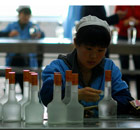Society
4 old structures closed after collapse; 4,000 face checks
By Ming Yeung and Guo Jiaxue (China Daily)
Updated: 2010-02-02 08:36
 |
Large Medium Small |
HONG KONG: More than 70 residents of a building that collapsed last Friday in Hong Kong's Hung Hom area, killing four people and injuring two, and four other structures that were subsequently found dangerous were moved into temporary accommodations yesterday.
A total of 32 families found themselves homeless after the local government ordered four old buildings on Ma Tau Wai Road in Kowloon District to be repaired, following the collapse of the 50-year-old residential structure on the same street.
Authorities continue to investigate the cause of Friday's building collapse, which jolted the government into inspecting all old buildings in the Special Administrative Region.
Au Choi-kai, director of the Building Department of the Kowloon West Crime Unit, which has taken over the investigation, said: "We are still investigating to determine the cause of the collapse."
The department had inspected the building in early January and certified it as safe. The building turned into a pile of debris less than a month after the inspection.
A store on the ground floor of the building was undergoing renovations when the structure collapsed.
Au said his unit is investigating whether the renovation work on the ground floor caused the collapse.
The Building Department started inspecting about 4,000 buildings that are 50 years old or older since yesterday.
Forty teams, each comprising one technical officer and one building surveyor/structural engineer, will inspect and determine whether the structures of these buildings are safe.
Chan Chi Ming, head of the department of construction at the Hong Kong Institute of Vocational Education, said most old buildings in Hong Kong had safety issues.
He said the danger is usually related to improper alterations and additions in age-old buildings, which are unable to bear the load of change in wall structure.
Two buildings adjacent to the one that collapsed were declared unsafe soon after the tragedy and residents were evacuated.
Au said one of those two buildings was severely damaged and may be demolished.
Two more buildings were closed temporarily yesterday for repair work. The Building Department assured the structure of the two buildings was safe and the stabilization work will last no more than 14 days.
Cracks in old buildings are a natural phenomenon in aging buildings, Au said. But residents refuse to buy the theory.
Chan, who lives in a building a stone's throw from the one that collapsed, said: "I see cracks in my buildings every day. The structure we live in is obviously damaged. I hope the government can help us too, unless it wants to first see us buried under our own homes."
Relocating the evacuees has not been easy. About 30 of the 70 residents who were evacuated have no intentions of moving from their neighborhood.
"It is so inconvenient to live in the interim housing. It's too far away from everywhere. I prefer to relocate in the same district," said a man, surnamed Ng.
And concerns over the safety of the interim housing may also be one of reasons for people's reluctance to move. Shek Lei (II) Estate, where most evacuees are lodged, is more than 40 years old.
The Housing Department had carried out an investigation to determine the safety of buildings in Shek Lei (II) Estate. Findings of a 2008 survey revealed that the structures of the buildings were safe but needed repair work, a spokesman for the department said.
Winky So, Kowloon City District Officer, said the government tried to minimize pressure on the evacuees.
"Those who do not want to live in Shek Lei Estate could temporarily live in the Henry G. Leong Yaumatei Community Centre.
"We will pass their requests to responsible departments for follow-up. The government is hoping to meet their needs," she said.
Lawmaker Priscilla Leung encouraged the administration to make a quick fix to an unexpected disaster like this, as the number of affected people is limited.












